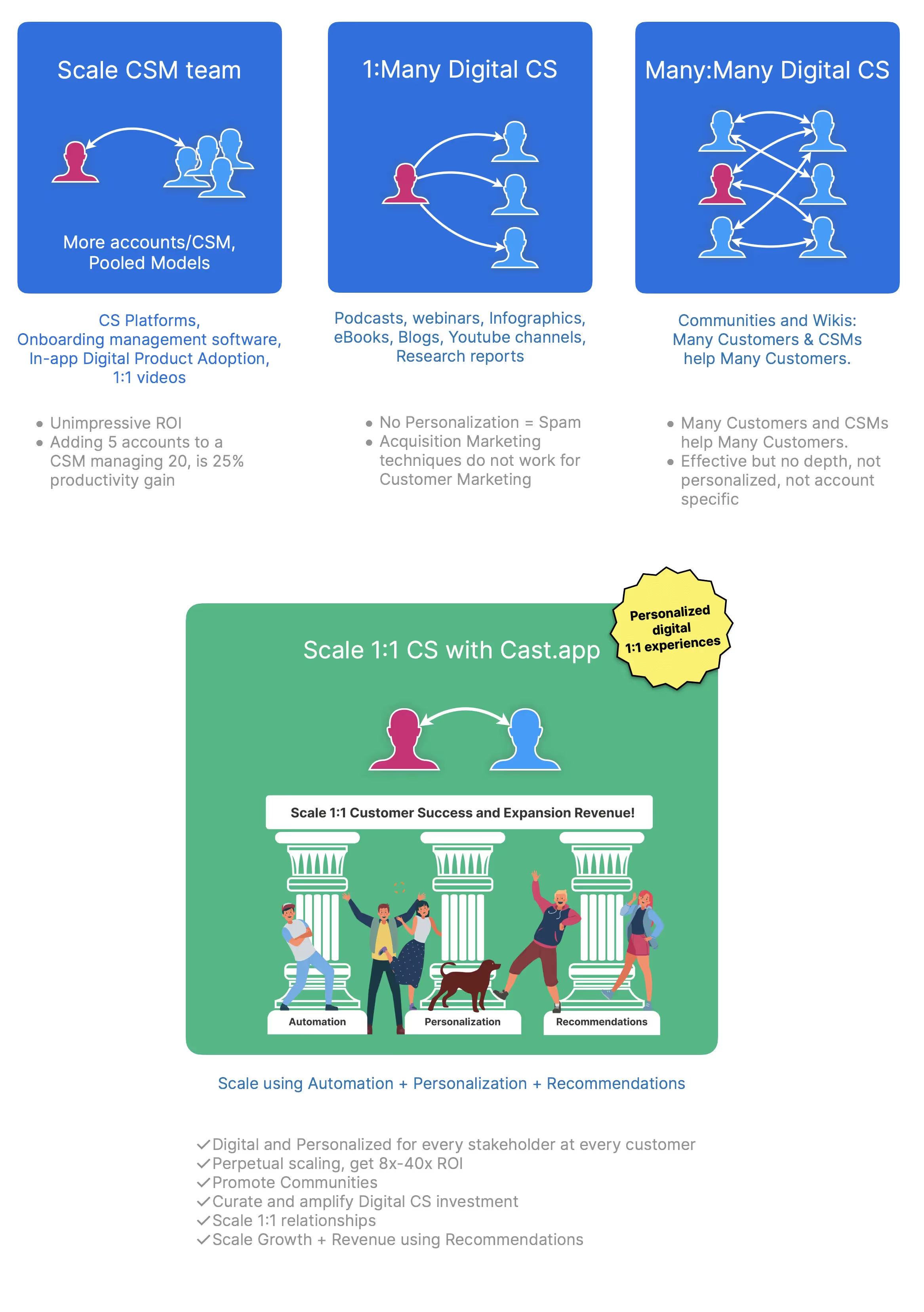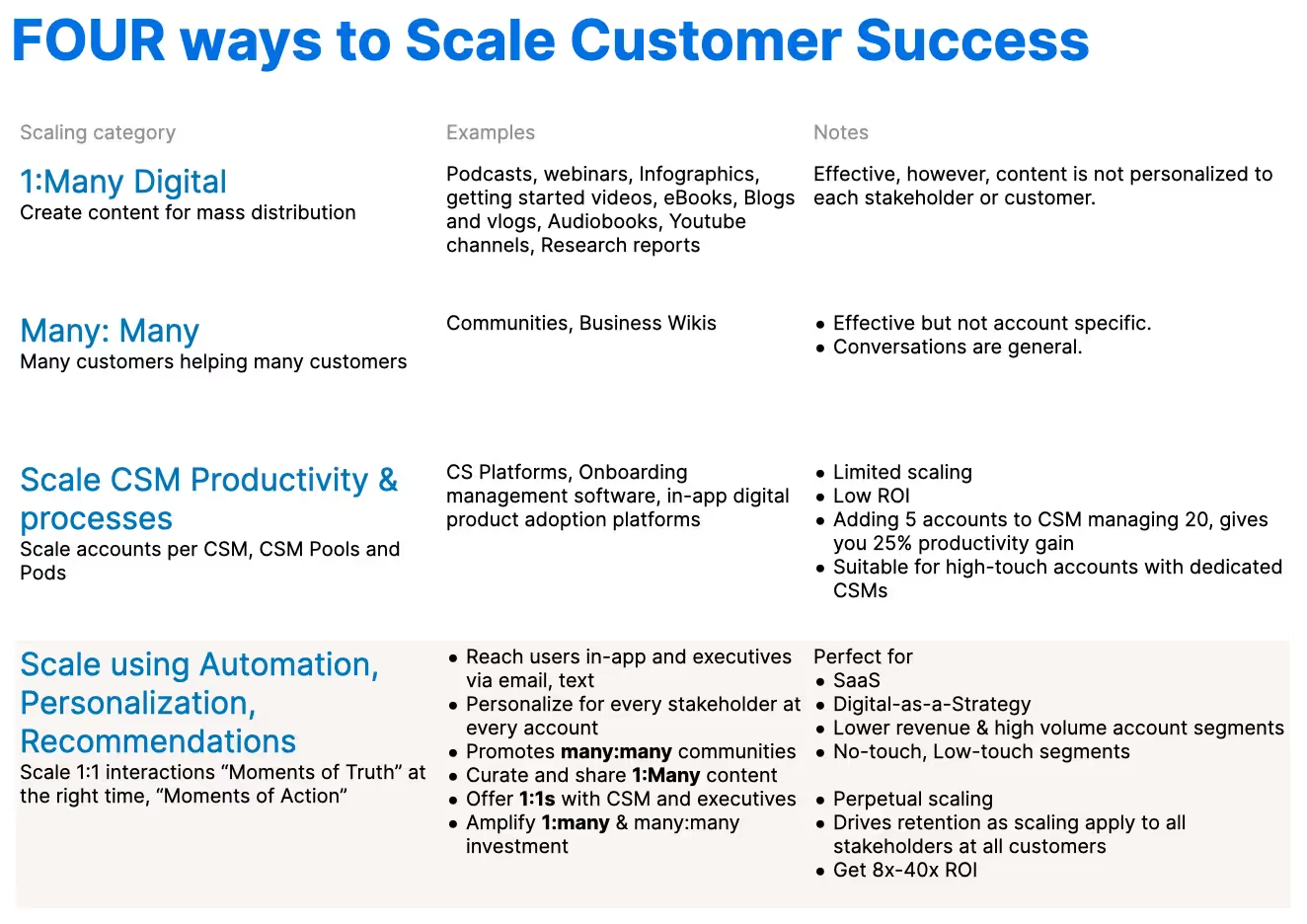The Existing Customer Focus
As your business scales and grows, more and more of your revenue will come from existing customers.
Consider these numbers from Salesforce, UIPath, and other successful companies:
- 73% of Salesforce revenue comes from existing customers — 36% from up-sells and upgrades and 37% from cross-sells.
- 75% of UiPath's revenue comes from existing customers.
- Slack and Zoom also see more revenue from existing customers.

Inversely, to scale and grow as a business, you must focus on existing customers.
Capturing more revenue from existing customers
To capture more revenue from existing customers,
- You have to retain existing customers, improve product usage, drive product adoption, and recommend features (up-sell) and products (cross-sell) that may help your customers.
- In addition, you must provide value to several stakeholders at your customer, including users and executives or economic buyers of your product or service. Providing value to several stakeholders is the single most effective way to increase stickiness and retain customers.
- Finally, you have to communicate your product's value to all customer stakeholders, sharing relevant recommendations to drive revenue and product usage.
The best part — focusing on existing customers is not only rewarding, it is cost-effective.
According to a commonly used Bain statistic, the cost of acquiring new customers (CAC) is 6.4 times the cost of retaining, upselling, and cross-selling to existing customers.
Scaling is a necessity
- The cost of acquiring new customers has increased 60% in the last five years, while the willingness to pay for features has dropped by 30% — via Profitwell.
- Because of the increased competition — and easier to onboard, use, and adopt new products — the time, money, effort, and the emotional cost of switching between products continues to fall.
- Most recently, SaaS businesses targeted an ARPA (average revenue per account) of hundreds of thousands of dollars. With PLG and self-service products, that's changing to an ARPA of tens of thousands of dollars, or as Chris Janz from Point Nine Capital would put it, a strategic shift from elephant-hunting to deer-hunting.
Now with lower switching costs, rising acquisition costs, lower ARPA, coupled with lower willingness to pay means as your CAC goes up, your profitability goes down. Therefore, you need to serve more accounts to sustain as a SaaS business.
So what that equates to is we have to provide a magnitude higher value and return on investment to our customers. That also means we have to scale customer success, renewals, and revenue expansion.
Ever wonder why CCOs are becoming CEOs?
Businesses are recognizing the need to serve existing customers and scale with a focus on existing customers. CCOs are best equipped to grow Net Revenue Retention.
Let us categorize Customer Success Scaling Strategies. Businesses scale Customer Success via a combination of several scaling strategies.
Let's start with the most popular one, 1) using productivity tools to scale the Customer Success Manager productivity. Next we will talk about 2) 1:many Digital CS and 3) many:many Communities.
Finally we will talk about how 4) automation, personalization, and recommendations can scale CS with a magnitude higher ROI. And how it amplifies your 1:many digital and many:many community investment, with curated recommendations.


Scaling Strategy Category #1
Scaling CSM productivity
Several scaling efforts focus on making Customer Success Managers more productive by employing tools and products in the post-sales technology stack to handle more accounts per CSM.
Some businesses use both a CRM and a CS platform, and others use a CRM platform to record both CS and sales activities. Pipedrive, for instance, uses its own CRM to manage customer success activities.
A CRM tool typically manages relationships and interactions with prospects and customers focused on sales activities, contacts, opportunities, licenses, and revenue.
A CS platform tracks customer interactions and touchpoints at every step of a customer's journey. It includes onboarding, tracking renewals, customer satisfaction, product use, and customer escalations.
Who CSMs work together may differ for different segments. For example, a business may have dedicated CSMs for customer segments that need them. And use a pooled or pod arrangement for other segments.
Pooled CSMs
Pooled CSM models work well for high-volume and lower-revenue segments, where any CSM can work with any customer, depending on availability. Typically, every CSM has deep knowledge of the product and service and can rely on shared notes to help any customer in the segment. In addition, a pool of CSMs can help customers around the clock.
Skills-based Pooled CSMs
A customer typically has a relationship with a CSM or an account manager, and an expert CSM is brought in depending on need customer stage. For instance, an onboarding expert can help during onboarding, and a CSM with expertise with a specific feature may help when a customer needs help with that feature.
Pod CSMs
A group of 2 or more CSMs with deep knowledge about a customer's implementation together form a pod to serve several customers. For instance, if a dedicated CSM manages $2.5M in ARR across 20 accounts, a pod of 3 CSMs may manage $8M in ARR across 64 accounts. In addition, the pod-based CSM model provides continuity when a CSM is out on vacation and during transitions.
Knowledgebases and playbooks
A concrete example of scaling the productivity of CSMs is to use knowledgebases and playbooks. You start by noticing a pattern of customer problems that CSMs solve. You then document them in playbooks. Any CSM can execute a playbook when they see a similar problem for their customer. Typically, CS-Ops teams create and manage playbooks for CSMs. We will talk more about automating playbooks in one of the following sections.
A playbook tells you how (and when) to respond in an efficient and repeatable way at scale. It includes templates, best practices, strategies, collateral, and more. Organizations like Salesforce or Google have dozens of playbooks covering a broad range of topics. Having playbooks sets the standard for your operating procedures and allows you to train new hires quickly. It ensures all clients receive the same level of service. — Wayne McCulloch, The Seven Pillars of Customer Success.
Productivity tools get you an ROI in percentages.
If a customer success manager can handle 25 vs 20 accounts, that is a 25% gain in productivity.
Automation tools discussed below get a magnitude higher ROI, ranging from 8x to 40x, depending on the number of customers you have.
Scaling Strategy Category #2
1:Many Scaling Strategy
1:many entails creating valuable content for your customers and sharing it broadly with the masses. Again, these are pretty common and well-documented strategies, and we will not go into details except to list some examples. It is important to note 1:many is not personalized.
- Podcasts
- Live webinars or webinar recordings
- How-to-videos
- Infographics
- Publishing best practices
- Pre-recorded training sessions
- Getting started videos
- eBooks & Books
- Blogs and vlogs
- Audiobooks
- Youtube channels and playlists
- Research reports
Scaling Strategy Category #3
Many:Many Scaling Strategy
Communities
Another effective way to scale is to have your customers help your other customers and share best practices and how-tos via a community. A business can create community where several individuals are ready to help, educate, and learn from each other.
Insided.com (Gainsight), Hivebright, HigherLogic, Discourse, Influitive, tribe, and Slack are community platform providers.
Disclosure: Several Gainsight and Insided.com executives are investors in cast.app.
Business Wikis
Another many:many scaling strategy is a business-specific encyclopedia managed by employees and invited customers.
Guru, Notion, and Confluence are some of many examples of business wikipedias widely used by businesses.
Scaling Strategy Category #4
Scaling 1:1 CS with Personalization and Automation
If you step back and look, our customers have several interactions with our business. All customer interactions have to be positive, whether you're talking to a salesperson, a Customer Success Manager, a support person, or have office hours with an exec. Or even digitally on the website or in your product.
Now, CSMs can maintain these intimate relationships with customers when you have dedicated CSMs and a small portfolio of customers. The problem is you cannot replicate white-glove experiences in environments when you have several customers — from thousands to millions — especially when you don't have that many CSMs for all those accounts.
So how do you scale 1:1 CS? You automate the top positive interactions.
Automating even the top positive interactions or what the industry calls Moments of Truth or emotional experiences can be very financially rewarding.
- For one instance, if you have playbooks that work for one-on-one named accounts, consider automating the top-few.
- You could send a notification directly to the customer on behalf of a CSM or the person that has the best relationship. And when they respond involve the CSM.
- You could send a notification directly to the CSM.
- You could send a automated presentation to a customer and automate followup
- Ask the customer to fill some forms.
- You can take several complex multi-step interactions resulting from a playbook trigger and then automate them.
You do not have to attempt to automate everything. You can start by automating maybe just the QBR, the Digital Business Review, or one playbook for a specific segment. And then, you can iteratively digitize additional playbooks or additional segments. But it's always good to start small, understand how your market responds, and then take it further. And very soon, you can kind of end up with your own custom sophisticated automated engine that works for your business and your users, freeing up CSMs to be strategic problem solvers — what they signed up for!
Cast.app helps automate, personalize, and scale CS using this strategy.
Learn how cast.app helps scale customer success and revenue growth using automation, personalization, and actionable recommendations for every stakeholder at every customer. Learn more